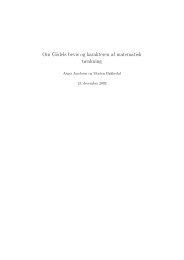Master Dissertation
Master Dissertation
Master Dissertation
You also want an ePaper? Increase the reach of your titles
YUMPU automatically turns print PDFs into web optimized ePapers that Google loves.
Let n, m ∈ N then<br />
and<br />
Hence<br />
mf( n n<br />
n<br />
) = f( ) + · · · + f(<br />
m m m ) = f(m<br />
<br />
m terms<br />
n<br />
) = f(n)<br />
m<br />
f(n) = nf(1).<br />
f( n n<br />
) =<br />
m m f(1).<br />
Since ρ0 is continuous f(x) = xf(1) for all x > 0.<br />
Thus<br />
ρ0(e x ) = e f(x) = e xf(1) ,<br />
that is, substituting x = ln a,<br />
Let ω := f(1).<br />
ρ0(a) = e f(1) ln(a) ln af(1)<br />
= e = a f(1) .<br />
Note that (7.5) is the condition of a regularly varying function.<br />
We regard ω as an indication of how singular a causal distribution is near<br />
{0}. This leads us to define:<br />
Definition 7.4. The distribution d ∈ S ′ (R m ) is called singular of order ω,<br />
if it has a quasi-asymptotics d0(x) at x = 0, or its Fourier transform has<br />
quasi-asymptotics ˆ d0(p) at p = ∞, respectively, with power-counting<br />
function ρ(δ) satisfying<br />
for each a > 0.<br />
ρ(aδ)<br />
lim<br />
δ→0 ρ(δ) = aω ,<br />
Note that d0 = 0 in (7.1) and the corresponding requirement in (7.2),<br />
respectively, are required to make sure that the singular order is uniquely<br />
defined. If we skipped the requirement any ω ′ ≥ ω could be chosen as<br />
singular order.<br />
Fixme: It this explained well enough?<br />
Lemma 7.5. The distributions d0 and ˆ d0 are homogeneous of degree<br />
−(m + ω) and ω respectively.<br />
Proof. From (7.6) and (7.5),<br />
Hence by Proposition 1.12<br />
a −ω 〈 ˆ d0(p), ˇ φ(p)〉 = a m 〈 ˆ d0(p), ˇ φ(ap)〉.<br />
〈 ˆ d0( p<br />
a ), ˇ φ(p)〉 = a m 〈 ˆ d0(p), ˇ φ(ap)〉 = a −ω 〈 ˆ d0(p), ˇ φ(p)〉. (7.7)<br />
52



